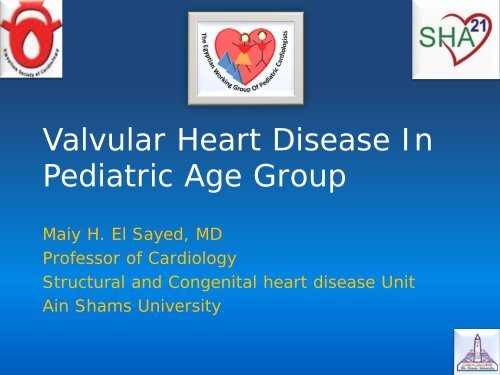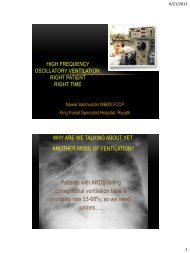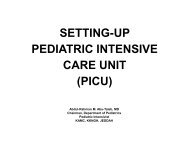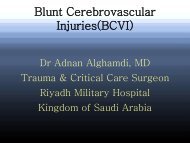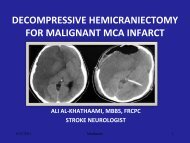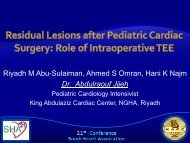Valvular Heart Disease In Pediatric Age Group - RM Solutions
Valvular Heart Disease In Pediatric Age Group - RM Solutions
Valvular Heart Disease In Pediatric Age Group - RM Solutions
Create successful ePaper yourself
Turn your PDF publications into a flip-book with our unique Google optimized e-Paper software.
<strong>Valvular</strong> <strong>Heart</strong> <strong>Disease</strong> <strong>In</strong><br />
<strong>Pediatric</strong> <strong>Age</strong> <strong>Group</strong><br />
Maiy H. El Sayed, MD<br />
Professor of Cardiology<br />
Structural and Congenital heart disease Unit<br />
Ain Shams University
<strong>Valvular</strong> <strong>Heart</strong> <strong>Disease</strong> <strong>In</strong><br />
Children<br />
Congenital<br />
Acquired<br />
•Stenotic<br />
•Regurgitant<br />
•Imperforate<br />
•Prolapsing<br />
•Straddling<br />
•Overriding<br />
Rheumatic heart disease
Overview Of The Problem<br />
• The child with significant valvular heart disease<br />
may present in any single instance both the most<br />
difficult of management decisions or a<br />
surprisingly simple one.<br />
• If a direct interventional or surgical approach on<br />
the valve is feasible, the problems may very well<br />
be quite simple and straightforward; conversely,<br />
if complex intervention or valve replacement is<br />
indicated such may not be the case.
Balloon Valvuloplasty Of Stenotic<br />
Lesions 2008,2009<br />
No M F<br />
BPV 280 154 126<br />
BAV 50 35 15<br />
BMV 43 18 25<br />
18% of total number of<br />
pediatric cardiac<br />
catheterization<br />
procedures, 50% of<br />
pediatric cardiac<br />
interventions
<strong>Age</strong><br />
Mean age [ years ]<br />
BPV 4.2<br />
BAV 4.1<br />
BMV 14.6
Gradient<br />
before<br />
[mmHg]<br />
Gradient<br />
after<br />
[mmHg]<br />
BPV 90.3 20<br />
BAV 95.8 25<br />
BMV 29.4 2.2
Technique<br />
BPV
Valvuloplasty<br />
Balloon Aortic Valvuloplasty<br />
Valvuloplasty balloon passed retrograde across stenotic aortic valve
Antegrade BAV
Antegrade BAV
Antegrade BAV<br />
Negative jet
Valvuloplasty<br />
Balloon Mitral Valvuloplasty
Morphologic And Hemodynamic<br />
Consequences After Balloon Pulmonary<br />
Valvuloplasty <strong>In</strong> <strong>In</strong>fants: Medium Term<br />
Follow Up<br />
• N = 76 < 1 Y<br />
• M = 62.5%, F = 37.5%<br />
• 72 critical PS, 4 PA/IVS. [ imperforate valve]<br />
• 2007 – 2009.<br />
• <strong>Age</strong>:- 1w – 12m.<br />
• Wt :- 3 – 9.5 kgs.<br />
• BSA:- 0.22 – 0.56m 2.<br />
• 31.8% cyanosis at rest.<br />
• 85% immediate success rate [ reduction of<br />
≥50% 0f RVP]
Stretched PFO with right to left shunt
Pulmonary valve morphology
Baseline Echocardiographic And Angiographic<br />
Data<br />
Mean ± SD<br />
Range<br />
Peak PG 93.3 ± 28.2 60 - 165<br />
RVSP 115.6 ± 33.8 80 - 195<br />
P.annulus (mm) 8.14 ±1.45 4 – 12<br />
P. annulus Z score<br />
PR 0%<br />
TR 55.6%<br />
RVH 72.3%<br />
-1.11 ±1.03 -3.1 – 0.4
Procedural findings<br />
Range<br />
Balloon size(mm) 2.5-16<br />
Ratio B/A ratio 0.9-1.6<br />
Transvalvular PG before dilatation(mmHg) 50-135<br />
Transvalvular PG after dilatation(mmHg) 5-65
28.1%<br />
71.9%
Technique in neonates??<br />
Wire support in PDA
Supra valvular – use of high pressure balloons
PTCA 2.5mm Balloon PTCA 3.5mm Balloon Double Balloon
PDA Stenting + PV perforation
PDA Stenting + PV perforation<br />
3x18mm Apolo
PDA Stenting + PV perforation<br />
Stiff end of 0.025 wire
2.5x20 Mavrek
10 m later - BPV<br />
7x20mm Tyshak mini
10 m later - BPV<br />
Diastole<br />
Systole<br />
<strong>In</strong>fundibular reaction<br />
[ dynamic obstruction]
Immediate Hemodynamic And Morphologic<br />
Effects Of BPV<br />
mean
Immediate Hemodynamic And Morphologic<br />
Effects Of BPV<br />
Before BPV<br />
After BPV<br />
Pulmonary<br />
regurgitation<br />
0% 64%<br />
Tricuspid<br />
regurgitation 55.8% 55.8%
Relation Between Development Of Pulmonary<br />
Regurgitation And Balloon/Annulus Ratio<br />
PR None Mild Moderate Severe<br />
B/A ratio 1.12±0.02 1.29±0.05 1.42±0.09 1.5±0.12
Complication Of BPV-PA/IVS<br />
• Transient apnoea. 46%<br />
• Sinus bradycardia 27.7%<br />
• Self limiting perforations. 3.8%<br />
• Transient loss of femoral pulse . 6.08%<br />
• Death 6.5%<br />
1 → PS → Pulmonary annulus rupture. (B/A= 1.25)<br />
2 → critical PS – cardio pulmonary arrest during procedure<br />
1 → PA/IVS one week after BPV (necrotizing enterocolitis).<br />
1 → PA/IVS 10 days following procedure.
Follow Up After BPV<br />
3,6,12months
Correlation between growth of pulmonary annulus (change of z<br />
score) and the baseline annular size before dilatation<br />
(inverse correlation)<br />
increase in p annulus z score<br />
3.5<br />
3<br />
2.5<br />
2<br />
1.5<br />
1<br />
0.5<br />
R=0.74 & p=0.0001<br />
-4 -3 -2 -1 0 1<br />
P annulus Z score at baseline<br />
0<br />
The smaller the annulus, the more growth occurring in medium term follow<br />
up
%<br />
Follow Up
Multi-variant Analysis For Factors Affecting Successful<br />
BPV<br />
Variables<br />
Successful (mean±SD<br />
or %)<br />
Unsuccessful<br />
(mean±SD or %)<br />
<strong>Age</strong> 5.833 ± 3.029 4.5 ± 2.784 0.368 (NS)<br />
Gender (m/f) (62.96%/37.04%) (60%/40%) 0.9 (NS)<br />
P<br />
RV-PA before<br />
PVBD (mmHg)<br />
RV-PA PG<br />
immediate<br />
after PBV<br />
82.407 ± 24.114 83 ± 24.393 0.96(NS)<br />
15.852 ± 7.107 27.5 ± 14.434 0.013 (S)<br />
SPAP (mmHg) 22.444 ± 7.607 25.5 ± 19.942 0.559 (NS)<br />
B/A ratio 1.342 ± 0.153 1.494 ± 0.167 0.053 (NS)<br />
RVSP before<br />
(mmHg)<br />
RVSP after<br />
(mmHg)<br />
PV annulus<br />
(mm)<br />
TV annulus<br />
(mm)<br />
<strong>In</strong>fundibular<br />
hypertrophy<br />
103.889 ± 25.508 109 ± 24.083 0.681 (NS)<br />
40.482 ± 8.519 65 ± 19.149 0.000 (HS)<br />
10.219 ± 1.631 8.833 ± 1.258 0.168 (NS)<br />
15.944 ± 2.199 15.3 ± 1.609 0.628 (NS)<br />
14.81% 40% 0.185 (NS)
Observations And<br />
Conclusions<br />
• RV dilatation starts to regress as early as 2 -3<br />
weeks following successful BPV.<br />
• Early intervention → better results.<br />
• Balloon dilatation of critical PS is the treatment of<br />
choice with surgery being reserved to the severely<br />
dysplastic & deformed valves /supravalvular PS.<br />
• Well equipped lab – trained personnel – PICU.


